Clematis Blue Light - planting and care
Bred in 1998 by Dutch breeders, Clematis Blue Light is a derivative of Mrs. Cholmondeley. Originator - Frans van Haastert. It belongs to the group of early large-flowered varieties. Consider the main characteristics, planting and care rules.
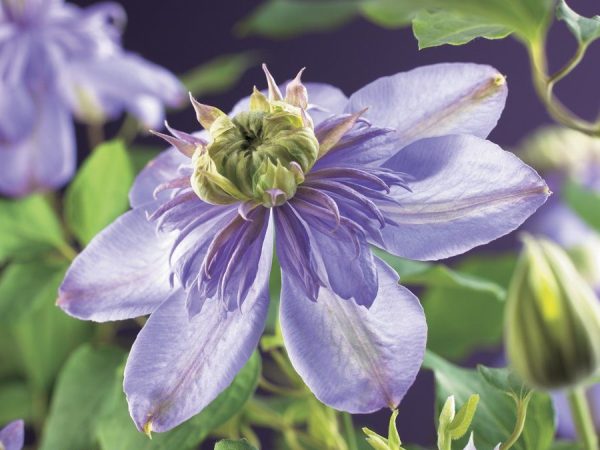
Blue light clematis
general description
The scientific name is clematis blue light.
The liana-shaped shrub has long shoots, the maximum height is 2.5 m. The inflorescences are large, double, with a diameter of 12-15 cm. The shade is violet-blue.
It blooms twice a year: the first time on last year's branches from May to June, the second time on a young growth from July to the end of August.
The root system is well developed, superficial, branched.
The plant has a good degree of frost resistance and high immunity against diseases, provided that all agricultural rules are followed.
Landing rules
The best time to plant is mid to late April. By this time, the soil will warm up well and the above-zero temperature has stabilized. You need to plant it before the beginning of the blooming of vegetative buds.
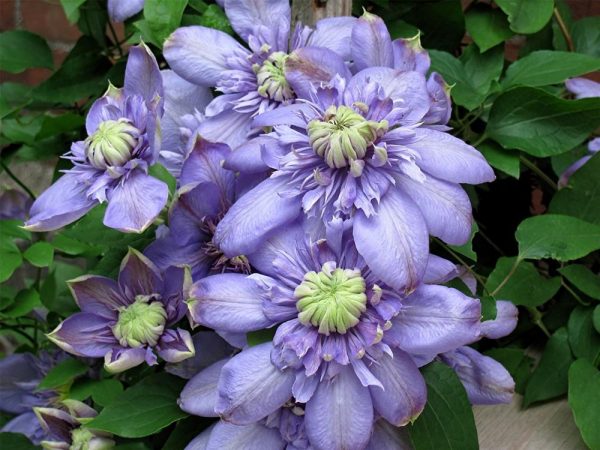
Variety of clematis blue light
In the south, gardeners are planted in early autumn - until the end of September. So the seedlings have time to take root and prepare for the winter.
Place and soil
Clematis prefer to grow in a sunny location, but with a little shade during lunch hours. So foliage and inflorescences will be protected from burns. It is better to plant it in a windless area, where there is no swampiness. The optimum depth of groundwater is 2-2.5 m.
The liana-like plant must be planted next to the support - near the arch, pergola. When planting near the walls of a house, a farm building, you need to indent by 0.5 m so that the root system fully develops.
The soil is suitable for light, loose, with a high content of humus and organic matter. The area cleared of weeds and garden debris is sprinkled with compost or humus - 20 kg / m². If the soil is heavy and knocked down, add a couple of buckets of sand or vermiculite.
It grows poorly on acidified soil, the optimal indicator is 6-7 units. If it exceeds the norm, add a deoxidizer - dolomite flour, slaked lime or chalk (400 g per 1 m²). After that, deep digging, leveling and watering are carried out.
Seedling preparation
To grow a beautiful shrub with all varietal characteristics, you need to purchase a seedling in a horticultural nursery.
It is important to choose a strong and healthy planting material, you can determine its condition according to the following criteria:
- the crown consists of several stems, densely covered with foliage;
- shoots are flexible, do not contain mechanical injuries, cracks, breaks, mold;
- leaves and buds are juicy, saturated green.
Saplings are sold with closed roots - in an earthen coma or in a plastic container. The shipping soil protects them from drying out.
Preparing a plant before planting consists of two stages: first, the root system is removed from the pot and immersed in cold water. Soak for two hours. After that, the roots are cut to 2-3 cm in length. These techniques ensure the rapid development of new roots.
Landing technology
In group cultivation, the distance between the seedlings is at least 1 m.The depth of the pit is 60-70 cm, the width is 50-55 cm.
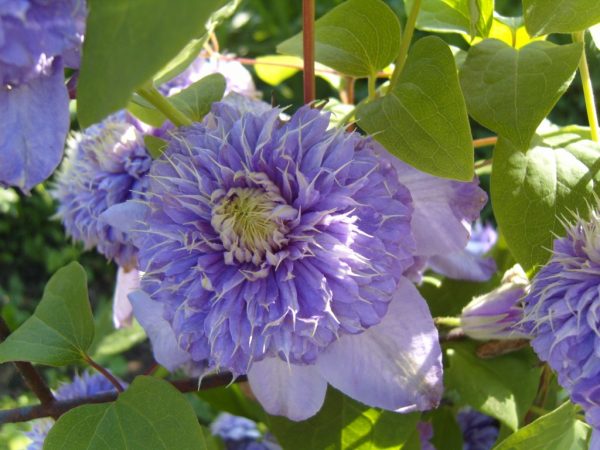
Clematis blue light
The pit is prepared two weeks before disembarkation so that the nutrients embedded in it have time to settle.
- A drainage layer of pebbles, crushed stone or screenings is laid at the bottom.
- Half the volume is filled with a mixture of dug earth, leaf compost or humus in a 1: 1 ratio.
- 100 g of superphosphate, 80 g of potassium sulfate and 300 g of ash are added.
The nutrient composition is trampled down, a hole is pulled out in the center, the rhizome is lowered into it, covered with soil mixture, compacted.
After planting, the plants are watered with warm water (20 l), then mulched with sawdust, peat or rotted manure. A support is installed next to it, the stems are tied to it.
If you have purchased a bush with lignified shoots, you need to deepen the root collar by 10-12 cm. Seedlings with a young growth are planted without deepening, otherwise the branches will quickly rot and the plant will die.
In the first two weeks, clematis needs to be shaded from the sun - this eliminates the risk of wilting and drying out of the crown. Use burlap or agrofiber. In order to avoid drying out of the superficial root system, stunted flowers - calendula, marigolds - are planted in the area of the trunk circle. They not only shade, but also scare away harmful insects.
Care requirements
Watering
In the first month, the seedlings are watered daily to speed up rooting and green mass growth. 5 liters of water are poured under each bush.
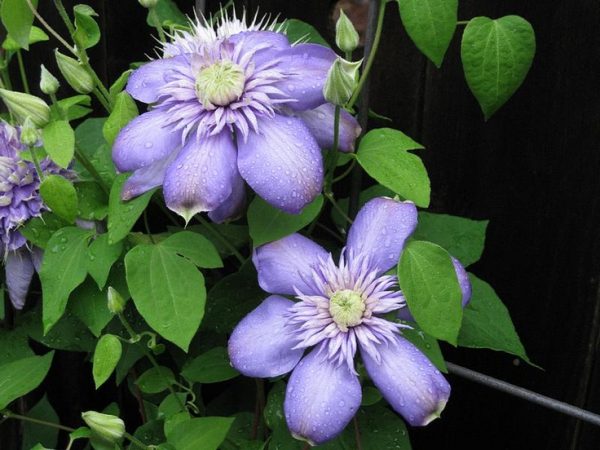
Clematis blue light description
Further moistening is carried out taking into account seasonal precipitation. If the soil has dried out to a depth of 4-5 cm, the shrub must be watered. Be sure to watered in early spring, before flowering, after its end and in late autumn, when clematis will shed its leaves. Use warm and settled water to prevent hypothermia of the roots.
In dry and hot summers, liana can be irrigated with warm water. Sprinkling increases decorative effect, removes dust and prevents the invasion of parasites.
Loosening is not required for this variety, because during this procedure, you can damage the superficial root system. As it grows, weeds are removed, periodically they add mulch from peat, compost or humus.
Top dressing
The first years, the bushes will fully develop, feeding on useful components laid down during planting.
Then they need to be fed several times per season:
- in early spring, for a quick build-up of young growth, the trunk circle is spilled with a solution of urea or nitrophoska - 15 g per bucket of water;
- before flowering, watered with a liquid complex composition of superphosphate and potassium sulfate - 15 g per 10 liters of water;
- in the budding phase, they are irrigated with a solution of carbamide, boric acid and potassium permanganate, which helps to extend the period and improve the quality of this process;
- in the fall, when the liana fades and sheds foliage, compost, rotted manure, is embedded in the soil.
Each meal is combined with watering to accelerate the absorption of nutrients and prevent root burning.
Pruning
The Blue Light variety belongs to the 2nd type of pruning, the procedure is carried out in two stages:
- after the first flowering, lignified vines are pruned to 4-5 buds, if the crown is thickened, some shoots can be cut into a ring;
- the second swift is carried out on young twigs after the buds have dried out.
Throughout the growing season, it is necessary to remove frozen, dry and wind-damaged stems or stems.
A well-sharpened and sterile instrument is used for cutting. The trimmed liana is irrigated with a solution of copper sulfate.This will help to avoid infection and promote the rapid tightening of the wounds.
Preparing for winter
Young clematis need good insulation, otherwise they will easily freeze out. A week before stable cold weather, the near-trunk zone is spud with a thick layer of peat, compost or humus.

Clematis blue light photo
The twigs are tied with a rope or twine, bent to the ground, fixed with staples, covered with fallen leaves, then spruce branches.
Under such insulation, clematis remains until spring. As soon as the snow melts and the last frost has passed, it is opened.
Reproduction
One of the main advantages of the perennial vine is the ability to easily and successfully reproduce in different parts. There are several options that gardeners use.
Cuttings
Planting material is harvested in spring or summer. From the top of the lignified stems, a green young growth 15-20 cm long with several buds and leaves is chosen.
At the bottom, all the foliage is cut off, placed in Kornevin's solution for an hour. This will help the shoots to root successfully.
They are planted in a moistened mixture of peat and sand to a depth of 4 cm. In order for the cuttings to grow roots faster, they are covered with transparent material, placed in a warm place with a temperature of 23-25 ° C and diffused daylight.
For 2-3 weeks - ventilate daily, moisten with warm water as needed.
New leaves are a sure sign of successful survival of shoots. Then the shelter is removed, they continue to water, and a month later they are planted in open ground.
By dividing the rhizome
This method of propagation is more suitable for older specimens that need rejuvenation or for plants with damaged roots.
The bush is watered abundantly when the soil softens, the rhizome is removed and placed in a container of water to wash off the remnants of the earth.
The dried root system is divided into parts, each should have 2-3 roots and one stem with buds.
To avoid infection, the cut sites are sprinkled with charcoal, after drying, they are seated separately.
Stem layering
In the fall, when the vine sheds its leaves, choose the most flexible lignified vine, which is close to the ground. They put it in a pre-dug groove, fix it with brackets, sprinkle it with a fertile composition of peat, sand and humus. All components are taken in equal quantities. The cuttings are watered, and a week before the stable cold weather they are covered with fallen leaves, covered with spruce branches.
It is dug up in the spring when the snow melts and the outside temperature reaches 8-10 ° C. The branch is cut from the mother plant. Then they are divided into parts, leaving roots on each. They are seated in the same way as purchased bushes.
Diseases and pests
With good care and maintenance, clematis blue light rarely gets sick. On weakened bushes growing in thickets, without regular watering, nutrition and pruning, various sores and parasites appear:
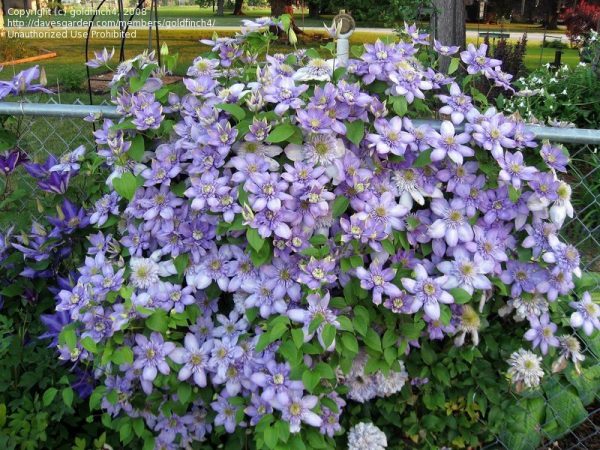
Clematis blue light planting and care
- Rust, powdery mildew, gray rot, ascochitosis. Such diseases can lead not only to the loss of decorativeness, but also to the death of the shrub. Before treatment, all diseased parts must be removed and burned. Then irrigate the crown with fungicides - Bordeaux mixture, copper sulfate, Ridomil gold, Skor or Hom. When the plant is damaged by Wilt (wilting), they dig it out, burn it. The place of growth is spilled with a raspberry solution of potassium permanganate.
- Of the pests, spider mites and aphids are annoying. Insects can be destroyed with the help of insecticides - Actellik, Karbofos or Aktara. To avoid the appearance of slugs and snails, sprinkle the trunk circles with wood ash or pine sawdust. If these parasites are affected, they are sprayed with a Thunderstorm or Slime-eater.
Simple preventive measures will help maintain the health and decorativeness of large-flowered liana:
- treatment in early spring and late autumn with a solution of copper sulfate or Bordeaux liquid;
- buying strong seedlings;
- adherence to deadlines and landing patterns;
- timely pruning of non-viable stems, leaves, removal of weeds;
- regular watering, top dressing.
Application
In landscape design, Blue Light clematis is one of the most popular, because have an unusual color of inflorescences and blooms twice a year.
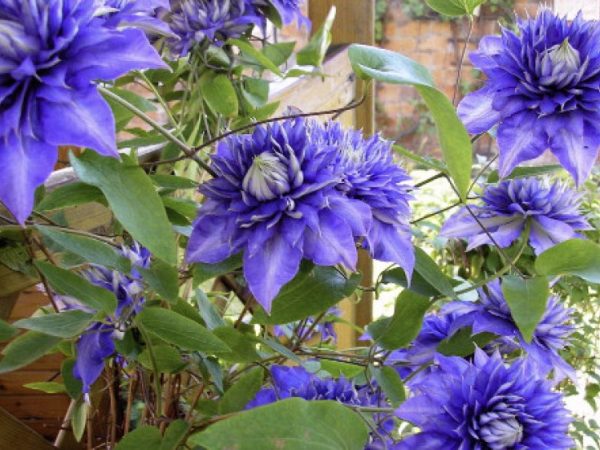
Blue light clematis:
They are used both in single and group plantings. Used for landscaping arches, pergolas, fences, gazebos and terraces.
They are planted together with other varieties of clematis, creating a multi-colored hedge.
Testimonials
Thanks to numerous positive reviews, this perennial has become widespread throughout Russia:
- good frost resistance and excellent disease resistance, helps to grow a beautiful and lush blooming liana in any climatic zone;
- successful reproduction with the preservation of all varietal characteristics in seedlings allows you to independently obtain new shrubs to decorate your personal plot;
- safely tolerates the neighborhood of other vegetation, therefore it is suitable for creating an original decoration.

